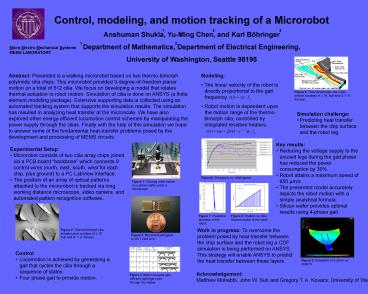Control, modeling, and motion tracking of a Microrobot PowerPoint PPT Presentation
1 / 1
Title: Control, modeling, and motion tracking of a Microrobot
1
Control, modeling, and motion tracking of a
Microrobot Anshuman Shukla, Yu-Ming Chen, and
Karl Böhringer Department of Mathematics,
Department of Electrical Engineering, University
of Washington, Seattle 98195
1
2
2
1
2
Micro Electro Mechanical SystemsMEMS LABORATORY
Abstract Presented is a walking microrobot based
on two thermo-bimorph polyimide cilia chips. This
microrobot provided 3-degree-of-freedom planar
motion on a total of 512 cilia. We focus on
developing a model that relates thermal actuation
to robot motion. Simulation of cilia is done on
ANSYS (a finite element modeling package).
Extensive supporting data is collected using an
automated tracking system that supports the
simulation results. The simulation has resulted
in analyzing heat transfer at the microscale. We
have also explored other energy-efficient
locomotion control schemes by manipulating the
power supply through the cilias. Finally with the
help of this simulation we hope to answer some of
the fundamental heat-transfer problems posed by
the development and processing of MEMS circuits.
- Modeling
- The linear velocity of the robot is directly
proportional to the gait frequency. - Robot motion is dependent upon the motion range
of the thermo-bimorph cilia, controlled by
integrated resistive heaters.
Figure 5 Thermal bimorph cilia cross section
courtesy of J. W. Suh and G. T. A Kovacs.
- Simulation challenge
- Predicting heat transfer between the chip surface
and the robot leg.
- Key results
- Reducing the voltage supply to the unused legs
during the gait phase has reduced the power
consumption by 30. - Robot attains a maximum speed of 650 µm/s.
- The presented model accurately depicts the robot
motion with a simple analytical formula. - Silicon wafer provides optimal results using
4-phase gait.
- Experimental Setup
- Microrobot consists of two cilia array chips
joined via a PCB-board backbone which connects
9 control wires (north, east, south, west for
each chip, plus ground) to a PC LabView
interface. - The position of an array of optical patterns
attached to the microrobot is tracked via long
working distance microscope, video camera, and
automated pattern recognition software.
Figure 6 Frequency vs. initial speed.
Figure 1 Tracking robot motion on a silicon
wafer under a microscope.
Figure 7 Positional deviation of the robot.
Figure 8 Position vs. time tracked motion of the
robot.
Work in progress To overcome the problem posed
by heat transfer between the chip surface and the
robot leg a CDF simulation is being performed on
ANSYS. This strategy will enable ANSYS to predict
the heat transfer between these layers.
Figure 2 Thermal bimorph cilia actuator pixel
courtesy of J. W. Suh and G. T. A. Kovacs.
Figure 3 Microrobot alongside to US 1 cent coin.
- Control
- Locomotion is achieved by generating a gait that
cycles the cilia through a sequence of states. - Four phase gait to provide motion.
Figure 9 Simulation of a cilium on ANSYS.
Acknowledgement Matthew Mohebbi, John W. Suh and
Gregory T. A. Kovacs University of Washington,
University of California, Stanford.
Figure 4 Motion towards right. Left and right
legs cycle through four states.

